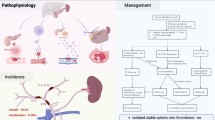Abstract
Snakebite associated thrombotic microangiopathy (TMA) is a spectrum of disorders characterized by microangiopathic hemolytic anemia, thrombocytopenia and acute kidney injury (AKI). We carried out this study to find out the prevalence of TMA in hematotoxic snake envenomation and to analyze its impact on the clinical outcome of patients. Retrospective data were collected from the medical records, hospital and lab information system after institutional ethics committee approval. Hematotoxic snake bite patients were categorized into Group 1 (with TMA) and Group 2 (without TMA). Chi square test, Mann–Whitney ‘U’ test and Odd’s ratio (OR) were used for statistical analysis. Out of 331 snakebite cases admitted, 202 (64.33%) were hematotoxic envenomation with a mean age of 42.26 ± 15.61. Majority were males with a male to female ratio of 2.01:1. Lower limb was the most common site of bite (59.9%). The prevalence of coagulopathy, TMA and AKI observed was 56.4, 18.8 and 37.6% respectively. AKI had a significant risk of undergoing hemodialysis when it was associated with TMA (r = 0.635, OR = 19.3182, P < 0.0001). Higher number of patients in Group 1 received more blood products (r = 0.406, OR = 8.525, P < 0.0001). Prolonged hospital stay (17.25 ± 12.23 vs. 8.86 ± 7.18 days, P < 0.0001) and higher complication rates were (33.33% vs. 11.4%, P < 0.0048) observed in patients with TMA. Snakebite associated TMA has a significant impact on the prognosis and understanding the pathophysiology of this entity will help to formulate guidelines.



Similar content being viewed by others
References
Gutierrez J, Calvette J, Habib A, Harrison R et al (2017) Snakebite envenoming. Nat Rev Dis Primers 3:17064
Isbister G, Little M, Cull G, McCoubrie D et al (2017) Thrombotic microangiopathy from Australian brown snake (Pseudonaja) envenoming. Intern Med J 37:523–528
Isbister G (2010) Snakebite doesn’t cause disseminated intravascular coagulation: coagulopathy and thrombotic microangiopathy in snake envenoming. Semin Thromb Hemost 36:444–451
Chugh K (1989) Snake-bite-induced acute renal failure in India. Kidney Int 35:891–907
Cobcroft R, Williams A, Cook D, Williams D et al (1997) Hemolytic uremic syndrome following taipan envenomation with response to plasmapheresis. Pathology 29:399–402
Berling I, Isbister G (2015) Hematologic effects and complications of snake envenoming. Transfus Med Rev 29:82–89
Hung D, Wu M, Deng J, Yang D et al (2002) Multiple thrombotic occlusions of vessels after Russell’s viper envenoming. Pharmacol Toxicol 91:106–110
Sitprija V (2006) Snakebite nephropathy (review article). Nephrology 11:442–448
Haemoglobin concentrations for the diagnosis of anaemia and assessment of severity WHO, 1 (2011). http://www.who.int/vmnis/indicators/hemoglobin.pdf. Accessed 1 Dec 2018
Khwaja A (2012) KDIGO clinical practice guidelines for acute kidney injury. Nephron 120:c179–c184
Casamento AJ, Isbister GK (2011) Thrombotic microangiopathy in two tiger snake envenomations. Anaesth Intensive Care 39:1124–1127
Kularatne S, Wimalasooriya S, Nazar K, Maduwage K (2014) Thrombotic microangiopathy following Russell’s viper (Daboia russelii) envenoming in Sri Lanka: a case report. Ceylon Med J 59:29
Gn Y, Ponnusamy A, Thimma V (2017) Snakebite induced thrombotic microangiopathy leading to renal cortical necrosis. Case Rep Nephrol. https://doi.org/10.1155/2017/1348749
Vikrant S, Jaryal A, Parashar A (2017) Clinicopathological spectrum of snake bite-induced acute kidney injury from India. World J Nephrol 6:150
Dhanapriya J, Dineshkumar T, Sakthirajan R, Thirumalvalavan K et al (2017) Thrombotic microangiopathy due to Viperidae bite: two case reports. Indian J Nephrol 27:161
Herath N, Wazil A, Kularatne S, Ratnatunga N et al (2012) Thrombotic microangiopathy and acute kidney injury in hump-nosed viper (Hypnale species) envenoming: a descriptive study in Sri Lanka. Toxicon 60:61–65
Mitrakrishnan J, Bandula C, Mitrakrishnan C, Somaratna K et al (2012) Haemolytic uremic syndrome a hitherto unreported complication of humpnosed viper envenomation. Indian J Hematol Blood Transfus 29:116–118
Masias C, Vasu S, Cataland S (2017) None of the above: thrombotic microangiopathy beyond TTP and HUS. Blood 129:2857–2863
Sunitha K, Hemshekhar M, Thushara R, Santhosh M et al (2015) Inflammation and oxidative stress in viper bite: an insight within and beyond. Toxicon 98:89–97
Isbister G, Buckley N, Page C, Scorgie F et al (2013) A randomized controlled trial of fresh frozen plasma for treating venom-induced consumption coagulopathy in cases of Australian snakebite (ASP-18). J Thromb Haemost 11:1310–1318
Zengin S, Yilmaz M, Al B, Yildirim C et al (2013) Plasma exchange as a complementary approach to snake bite treatment: an academic emergency department’s experiences. Transfus Apher Sci 49:494–498
Mohan G, Guduri PR, Shastry S (2019) Role of therapeutic plasma exchange in snakebite associated thrombotic microangiopathy—a case report with review of literature. J Clini Apher. https://doi.org/10.1002/jca.21691
Author information
Authors and Affiliations
Contributions
GM—The concept of this study, Formulated the study design, performed the study, Data analysis and Manuscript preparation. GPR—Data collection. SS—Interpretation of Data, Critical review and final approval of the manuscript. DK—Data analysis and review of the manuscript.
Corresponding author
Ethics declarations
Conflict of interest
The authors declare that they have no conflict of interest.
Additional information
Publisher's Note
Springer Nature remains neutral with regard to jurisdictional claims in published maps and institutional affiliations.
Rights and permissions
About this article
Cite this article
Mohan, G., Guduri, P.R., Shastry, S. et al. Thrombotic microangiopathy in hematotoxic snakebites and its impact on the prognosis: an entity often overlooked. J Thromb Thrombolysis 48, 475–482 (2019). https://doi.org/10.1007/s11239-019-01868-z
Published:
Issue Date:
DOI: https://doi.org/10.1007/s11239-019-01868-z




